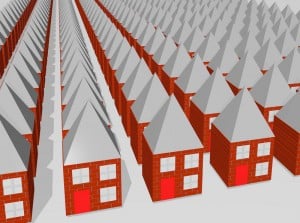Latest Residential Construction Activity Report

Building Permits
Privately owned housing units authorized by building permits in April were at a seasonally adjusted annual rate of 1,017,000. This is 14.3 percent (1.0%) above the revised March rate of 890,000 and is 35.8 percent (1.3%) above the April 2012 estimate of 749,000. Single-family authorizations in April were at a rate of 617,000; this is 3.0 percent (0.9%) above the revised March figure of 599,000. Authorizations of units in buildings with five units or more were at a rate of 374,000 in April.
Housing Starts
Privately owned housing starts in April were at a seasonally adjusted annual rate of 853,000. This is 16.5 percent (5.2%) below the revised March estimate of 1,021,000, but is 13.1 percent (5.1%) above the April 2012 rate of 754,000. Single-family housing starts in April were at a rate of 610,000; this is 2.1 percent (4.8%)* below the revised March figure of 623,000. The April rate for units in buildings with five units or more was 234,000.
Housing Completions
Privately owned housing completions in April were at a seasonally adjusted annual rate of 689,000. This is 14.3 percent (11.2%) below the revised March estimate of 804,000, but is 3.3 percent (11.9%)* above the April 2012 rate of 667,000. Single-family housing completions in April were at a rate of 536,000; this is 9.8 percent (10.2%)* below the revised March rate of 594,000. The April rate for units in buildings with five units or more was 149,000.
Notes
In interpreting changes in the statistics in this release, note that month-to-month changes in seasonally adjusted statistics often show movements which may be irregular. It may take 2 months to establish an underlying trend for building permit authorizations, 4 months for total starts, and 6 months for total completions. The statistics in this release are estimated from sample surveys and are subject to sampling variability as well as non-sampling error including bias and variance from response, non-reporting, and undercoverage. Estimated relative standard errors of the most recent data are shown in the tables. Whenever a statement such as 2.5 percent ( 3.2%) above appears in the text, this indicates the range (-0.7 to +5.7 percent) in which the actual percent change is likely to have occurred. All ranges given for percent changes are 90-percent confidence intervals and account only for sampling variability. If a range does not contain zero, the change is statistically significant. If it does contain zero, the change is not statistically significant; that is, it is uncertain whether there was an increase or decrease. The same policies apply to the confidence intervals for percent changes shown in the tables. On average, the preliminary seasonally adjusted estimates of total building permits, housing starts and housing completions are revised about three percent or less. Explanations of confidence intervals and sampling variability can be found on our web site listed above.
* 90% confidence interval includes zero. The Census Bureau does not have sufficient statistical evidence to conclude that the actual change is different from zero.
To read more about this release of housing construction activity, visit the Census Bureau website at http://www.census.gov/construction/nrc/
With AAOA, landlords have resources at their fingertips. Check out our new Landlord Forms Page.
American Apartment Owners Association offers discounts on products and services for landlords related to your rental housing investment, including rental forms, tenant debt collection, tenant background checks, insurance and financing. Find out more at www.joinaaoa.org.















 Accessibility
Accessibility